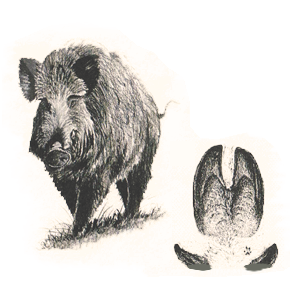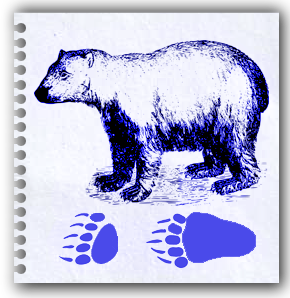When we go out into nature to do our trekking or climb the mythical mountains that await us, we enjoy the incredible landscapes that surround us with every step. Landscapes that hide not a few surprises in addition to being home to a large number of species, both plants and animals. Some inhabitants, as is the case of the fauna that populates the forests and mountains that we cross, that with luck we will be able to contemplate in their natural habitat, but that in general they take care of being seen.
Even so, as we walk the trails and paths of our hiking route, there are many marks and signs of its presence. Tufts of hair caught in fences, worn-out tree bark, food scraps or fruit nibbled in one way or another, are some of the many signs that in the eyes of an experienced naturalist tell us about the elusive inhabitants of the environment through which we pass, allowing us to identify them.
The footprints, which we have all certainly encountered, in the mudflats, in the snow or in the soft ground on which we move, allow us, without the need to be a learned naturalist, to recognize the elusive companions of the route.
Let's discover some of them together.



One of the inhabitants of our forests, pastures and mountains that we will most probably meet, even if only for a few seconds, on our hiking route is the deer. Its characteristic footprint is rectangular in shape and separated in two by the crevice that divides both hooves does not usually go unnoticed. It is usually just as deep from the front to the back, and due to the animal's size it is not usual to find them next to the mark of its upper hooves.
Sharing a certain similarity in their tracks, given their kinship with our friend the deer, the roe deer also leave tracks with two clear hooves separated by an inner channel. Due to the size of their footprints, somewhat smaller than those of the deer, they can be confused with those left by a fawn, so we must take into account other clear features that will allow us not to be confused. It is narrower and more pointed than the footprints left by the deer, characteristics that will allow us to identify them almost without a doubt.
Our next friend today can almost be seen more in some urban areas than in nature. The wild boar leaves a very characteristic, V-shaped footprint, clearly marked on the tips of the hoof, deeper than the rest of the footprint. Sometimes, depending on the terrain or the size of the boar, it also leaves its upper hooves marked, which stick out from the rear of the footprint.



It is not so usual to come across the footprints of these friendly rodents, as they spend a great deal of time going from branch to branch in the trees where they live. If we come across their footprints it will not be difficult to identify them, the length of their toes with five on their hind legs and four on their front legs, together with their unmistakable way of stepping, marking their four legs more or less together and leaving a generous space before leaving them marked again, will give us clear indications of their presence wherever we are.
Although we all have an image of otters as aquatic animals that rarely leave this environment, the truth is that they like to take their good walks mainly to leave their territory well marked. Their tracks are easily identifiable due to their size and shape, with their five well-defined fingers and a pad formed by several lobes. But surely these footprints will be accompanied by other different signs that this friendly animal leaves behind.
It is very probable that on many occasions we have come across the tracks of this singular animal without realizing it, some of the easiest tracks to identify. The badger usually steps on the footprints of its hind legs and its front legs, leaving its five toes clearly defined next to its powerful claws, both accompanied by a large, well-defined pad. The footprints of adult badgers are usually very large compared to other species of similar size.



This animal is nocturnal and is usually quite familiar with the presence of humans. Its footprints, with its five fingers and nails generally well marked next to a pad composed of several lobes, are common to find around rural urban centers where they usually live, although we can also find them in forests or rocks.
Perhaps the genet or rather its footprints are one of the most complicated to identify given its similarity to those of cats, hence its other name Musk Cat, another animal with a similar print is our friend the marten although with this one it is less likely to confuse them. There are several differences that we must observe to identify them, the first one is the size. Although both the cat and the genet normally do not leave their claws marked in their footprints, the smaller dimensions of the genet's footprint should help us to differentiate it. Another clear feature that distinguishes them is the lobes of the pad, in both cases there are three, but the cat's lobes are much more defined and marked.
Surely this is one of the best known footprints for all of us, along with those of dogs, but it is no less true that it is not easy to distinguish between a footprint of a wild cat and a footprint of a domestic cat, only the size, usually larger, of the mark left by the wild cat on its movements can help us to differentiate them without having to look at other signs that help us to decide that we are before the footprint of a wildcat.



Another of the animals that inhabit our forests and mountains that will make it difficult for us to differentiate their tracks due to their similarity to those of dogs is the fox. This animal, like the dog, leaves in its print the mark of four of its five fingers next to that of its main pad. Its more oval shape and its central fingers also more advanced than the lateral ones, compared to the prints of dogs, will serve as a reference. Aspects that are much more marked if we look at the footprints left by the hind legs.
He is another of our friends who must make it difficult for us to dare to identify his tracks without confusing them with those of a dog or a fox. On the paper, well drawn and clearly marked, their differences in size and shape no one would have any doubts, but on the ground things change and we will have to look at details such as the size, usually larger than the wolf's footprints. The nails of the wolf are sharper than those of the dog, or the line is much less wandering and the wolf and the fox are more direct than those of the dog, more likely to vary in direction by following some trail.
One of the most difficult to find and which, together with those of the wolves, can generate the most anxiety is the bear's footprints. Without a doubt its size and shape, different from the hind legs which are longer when stepping with the whole plant, while with the front legs they only do so with a small portion of it, leaving a footprint, the latter, as if the animal were a bamboo, when stepping with them in front, are unmistakable features of the presence of this animal in the environment.
Undoubtedly, one more incentive for our escapades to the mountains, the hiking routes or the excursions to the nature that in many cases only focus on reaching our objective without realizing the nourishing and interesting life that surrounds us in that adventure.
Remember, respect them and their natural environment and do not forget that they are wild animals.
We would be grateful if you could write to us to inform us of a ny erroneous or outdated information you have found, or simply to let us know what you think at Thank you very much.